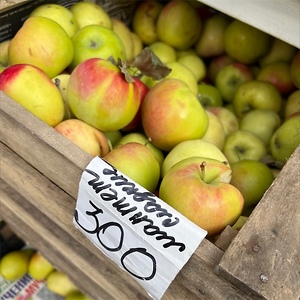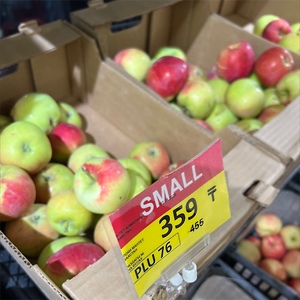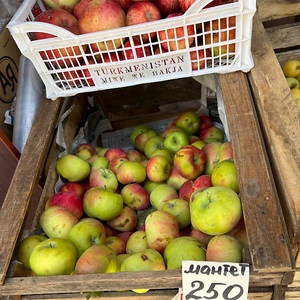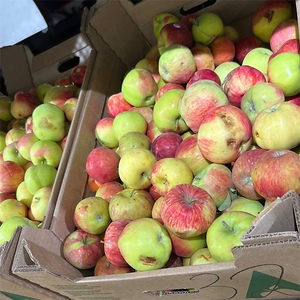


Mantet Apples
Estimated Inventory, 1 Lb : 0
Description/Taste
Mantet apples are moderately sized fruits, averaging 5 to 6 centimeters in diameter, and have a uniform, round to conical shape. The skin is smooth, glossy, and thin, easily bruised, and yellow-green when ripe, sometimes covered in dark red-orange striping and blush. The skin also bears prominent pale yellow to ivory lenticels. Underneath the surface, the flesh is white with pale green hues, dense, aqueous, and tender, encasing a central cavity filled with triangular, dark brown seeds. Mantet apples have a soft consistency without the firm crunch associated with other apple varieties. The cultivar also has low acidity, creating a very sweet, subtly tangy flavor with a honeyed, spice-like aroma.
Seasons/Availability
Mantet apples are available in the mid-summer through early fall.
Current Facts
Mantet apples, botanically classified as Malus domestica, are an early-maturing variety belonging to the Rosaceae family. The sweet, subacid fruits were developed in Canada in the 20th century, and the variety’s name is a combination of the province Manitoba, “Man,” and the parent variety tetofsky, or “Tet.” Mantet apples are highly favored among apple enthusiasts for their sweet flavor, uniform appearance, and summer ripening. Since their introduction, Mantet apples have spread around the world for home cultivation, and the variety is considered one of the most common garden cultivars in Russia. Mantet apples have thin, easily damaged skin preventing the variety from large-scale commercial cultivation. The cultivar also has a short shelf life, developing a cottony, flavorless nature after a few weeks in storage. Despite their lack of commercial cultivation, Mantet apples are grown for their sweet taste and are viewed as an early-season, fresh eating cultivar.
Nutritional Value
Mantet apples are a good source of vitamin C, an antioxidant that strengthens the immune system, reduces inflammation, and protects the body against free radicals. The fruits are also a good source of potassium to balance fluid levels within the body, fiber to cleanse the digestive tract, and contain lower amounts of iron, calcium, and magnesium.
Applications
Mantet apples are best suited for fresh eating as their sweet, soft-textured flesh is showcased when consumed straight, out-of-hand. The apples can be eaten as a snack, or they can be sliced and served on appetizer platters with dips, other fruits, nuts, and cheeses. Mantet apples can also be chopped into fruit bowls, tossed into salads, blended into smoothies, or pressed into juice. Beyond fresh applications, Mantet apples can be cooked into jams, jellies, and compotes, pureed into applesauce, or baked into crumbles, pies, and cakes. In Russia, Mantet apples are a favored variety for charlotte, a French-inspired caked filled with a mixture of fruit, custard, sponge cake, and whipped cream. Mantet apples pair well with vanilla, caramel, nut butter, fruits such as strawberries, raspberries, and blueberries, and spices such as nutmeg, cinnamon, cloves, and allspice. Whole, unwashed Mantet apples have a short shelf life and will keep 1 to 2 weeks when stored in the crisper drawer of the refrigerator.
Ethnic/Cultural Info
Mantet apples are one of the apple varieties highlighted during the Corn and Apple Festival in Morden, Manitoba. In 1925, the city of Morden was declared part of the corn and apple belt of Canada, and the city took pride as one of the few prairie towns with a long, warm growing season, fertile soil, and adequate rainfall. The city further celebrated its heritage in 1967, when they established the Corn and Apple Festival during Canada’s centennial celebration. The annual, late summer festival has grown into one of the largest celebrations in Manitoba, and during the event, there are beauty pageants, contests, parades, live entertainment, car shows, and dancing. The city estimates that over 50,000 people attend the festival, and apple varieties such as Mantet are proudly showcased through food vendors in pies, cakes, or crumbles. The Morden-born variety is also sampled fresh for visitors to taste while walking through the event.
Geography/History
Mantet apples were developed at an experimental research farm in the early 20th century in the city of Morden, located within the province of Southern Manitoba, Canada. The variety was created through a series of cross-pollinations, and the parent cultivars are believed to be the tetofsky apple, also known as the Russian grushovka moskovskaya apple, and the mcintosh apple. Mantet apples were one of the first varieties created under the Morden Research Branch, which is a part of the Canada Department of Agriculture, and the branch was run by Dominion Horticulturalist William Tyrrell Macoun. The variety was named in 1924 and released to growers in 1929. Once introduced, the cultivar quickly rose in popularity as a dessert cultivar and was later spread to the United States, Europe, and Central Asia for cultivation. Mantet apples became wildly popular in Russia as an early-ripening variety for home gardens. Today Mantet apples are grown through small farms and in home gardens and are primarily found for sale at local markets in North America, Europe, and Central Asia.
Recipe Ideas
Recipes that include Mantet Apples. One
| Simply Recipes |
|
Baked Apples |
| Taste of Home |
|
Apple Salad |
| The Adventure Bite |
|
Apple Cheese Bites |
| Life is But a Dish |
|
Easy Apple Crisp |
| Food Network |
|
Apple Charlotte |
| My Recipes |
|
Warm Cinnamon Apples |












